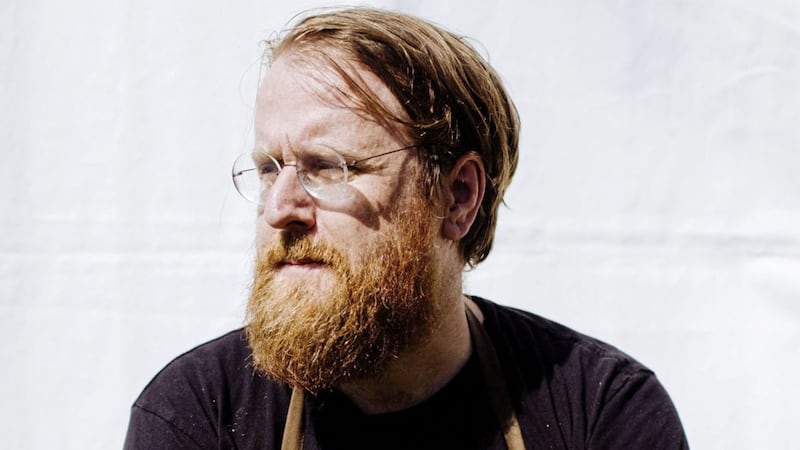WHAT did people eat for dinner 10,000 years ago? It's a question Irish chef JP McMahon considers a lot. "I'm always thinking about that period in time," says the author and food writer.
He finds himself endlessly intrigued as to whether the food then was "any more Irish than what we eat now", and says he's fascinated with how 'terroir' cooking (using indigenous ingredients) now would compare.
You can see why the Galway-based restaurateur was tasked with compiling new recipe compendium, The Irish Cookbook. The weighty collection investigates the 'peasant tradition' presumption, explores historical and contemporary cooking (McMahon went deep into Irish recipe archives), and champions the produce Ireland naturally offers up.
And it turns out, 10,000 years ago, Ireland's first settlements were busy with people scoffing stuff you'd still recognise today. "The three pinnacle foods would've been salmon, trout and eel," explains McMahon. "You also had a lot of wild game, duck – particularly mallard – pigeon and woodcock, and then a whole host of indigenous plants, such as wild garlic, nettles."
People would have also been cracking open oysters and scallops, mussels, cockles and clams, not to mention cooking up dishes of seal, puffin, squirrel and bear. The bears are of course all gone now though. "I don't think we ate them all...," McMahon notes wryly.
And no, he wasn't allowed to include a bear recipe in the book – despite the fact they "still eat bear in Canada" and "puffin in Iceland". Seal was even eaten "up until the 1950s" in a lot of the islands off Ireland itself. Flipper for supper, anyone?
When people think about Irish food though – your lamb and barley, beef and Guinness stews – McMahon says "they're really thinking about it in the last 200 years. A lot of these recipes only date to the 19th century, and once you go back beyond that point, it gets very, very messy," he adds.
So messy in fact, you get exotic things like meringue popping up, and more regionally, things like birch wine made from tapping and fermenting the sap of birch trees, "which was a common thing to do".
McMahon even discovered a recipe for pickled heron: "I had to ask a historian, because I was like, 'Do you think they meant to say herring?' But no – people would literally eat anything that would move.
"The fact someone wrote it down would mean it wasn't something people were eating out of starvation," he adds, quite impressed. "You had to gut and eviscerate 100 herons – that's a lot of birds."
It all makes writing a cookbook about 'Irish food' quite difficult – it's impossible to be definitive. For McMahon, "whatever was eaten in Ireland is part of Irish food" – but then that has to include the criss-cross of dishes between England and Ireland, the Chinese takeaways on every Irish high street, and his own restaurants, from the Michelin-starred Aniar, to casual tapas joint, Cava Bodega. "When we think about national cuisine, it doesn't really exist, it is a figment of our imagination."
Taste and flavour are very real though, even if some are taken for granted. Black pepper, spices, citrus – none are indigenous to Ireland, so McMahon will incorporate woodruff and meadowsweet, rather than cinnamon and allspice, when making a carrot cake of Irish terroir. He can't help but interrogate why people opted for far-flung spices, rather than what was readily available nearby.
Much can be put down to showing off – spices and sugar indicated wealth, while even the act of writing down recipes was acquired from elsewhere. Cookbooks, by women mainly, were introduced to Ireland via the English, when they began settling there in the 16th century, and "weren't part and parcel of the Irish canon, because post-independence we couldn't reconcile with our own history".
Some indigenous ingredients also just deserve more respect. McMahon would particularly like Ireland to be associated with "two very elemental foods" – seafood and seaweed. "They've been here a long, long time," he explains, but the tradition of seaweed is very small.
"How did Japan turn this stuff into gold and then we literally just use it as fertiliser?" he asks, dumbfounded. "Seaweed for me is just such an important foodstuff. There's so much we can do with it," he adds, listing everything from desserts to stews; it shouldn't be written off. "It is really, really nutritious, it's full of flavour and natural monosodium glutamate, it has that umami characteristic."
Game is another thing that, for some reason, people don't "treasure enough in Ireland". Blame the aristocratic English-Irish tradition again, for land ownership struggles, and the Normans for spawning the tradition of hunting for pleasure in the first place.
"It's still something we don't really embrace," says McMahon. "We get game in the restaurant from people who shoot it, but it is something we could appreciate better, and in this age of climate change, it's a very sustainable meat. It's literally killed and eaten, it's not intensely farmed, and there's a [need for] culls, and you need to balance that out."
Ideally, we'd all be better acquainted with what we're eating and where it comes from. "It's so important to be able to talk about what you're buying," says McMahon, "even if you're buying vegetables. Just being able to ask someone, 'Is that in season? Where is it from? What variety is that?'
"We just think a carrot is a carrot, or a plum is a plum. And the interesting thing is, when you look at all the recipes, [historically] they understood there are different varieties of plums, and some of them are better for some things than others."
The ubiquitous orange carrot is basically acting as shield to all the other knobbly, gnarly, sunset-hued carrots we could be crunching through. "There's a massive world of vegetables out there."
When he's not running his restaurants, or actually running (his Instagram feed is a mix of food and training updates), McMahon pulls together Food On The Edge, an annual international symposium of chefs in Galway, that looks at the future of food.
"For a lot of people, food is just a vehicle for hunger and nutrition, and for me, food should be a cultural experience," he says. "How do we reclaim that?" The Irish Cookbook is a good start.
:: The Irish Cookbook by Jp McMahon, photography and styling by Anita Murphy and Zania Koppe, is published by Phaidon. Below are three recipes from the book for you to try.
CODDLE
(Serves 8)
2tbsp rapeseed oil, plus extra if needed
500g sausages, cut into pieces if preferred
500g streaky bacon, cut into pieces
500g onions, sliced
2tbsp chopped thyme
2 bay leaves
1 litre chicken stock
1kg potatoes, peeled and cut into chunks
4tbsp chopped parsley
Freshly ground black pepper
Method:
Warm the oil in a large pan over a medium heat. Add the sausages and bacon and fry for about 10 minutes until they have a nice colour. Remove the meat from the pan and set aside.
Add the sliced onions to the pan and a little more oil if necessary. Reduce the heat and fry for about 10 minutes so that the onions caramelize slowly.
When the onions have a nice colour, return the sausages and bacon to the pan and add the thyme and bay leaves. Cover with the chicken stock (broth) and return to the boil. Reduce the heat to a simmer and add the potatoes. Cook for about 30 minutes.
Add the chopped parsley and plenty of black pepper and serve.
BROWN SODA BREAD WITH STOUT AND TREACLE
(Makes 2 loaves)
Rapeseed oil, for greasing
800g strong brown (wholewheat) bread flour
200g strong white bread flour
1tbsp bicarbonate of soda
20g sea salt
3 handfuls of mixed seeds (such as pumpkin seeds, sunflower seeds and linseeds/flaxseed)
200g treacle
2 eggs
850ml buttermilk
200ml stout
50g pinhead oats, for the topping
Method:
Preheat the oven to 130C/Gas Mark 3/4. Grease two 23 x 13 x 7-cm loaf pans. Stir all the dry ingredients together in a large mixing bowl. Add the treacle, eggs and buttermilk and combine, then add enough stout until you achieve a wet dough.
Pour the dough into the two prepared loaf pans, sprinkle the oats on top and bake in the preheated oven for one hour 30 minutes to one hour 45 minutes, until the loaves sound hollow when the bottoms are tapped or the core temperature is greater than 85C on a meat thermometer.




